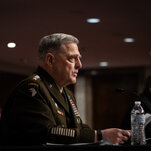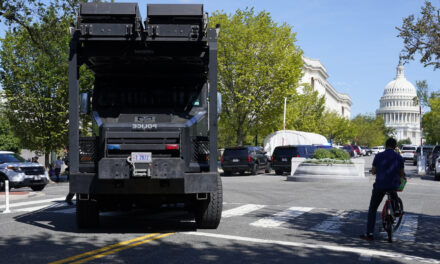
China’s Weapon Test Close to a ‘Sputnik Moment,’ U.S. General Says

Gen. Mark A. Milley said the Chinese test of a hypersonic missile “has all of our attention.”

WASHINGTON — A Chinese test of a hypersonic missile designed to evade American nuclear defenses was “very close” to a “Sputnik moment” for the United States, Gen. Mark A. Milley, the chairman of the Joint Chiefs of Staff, said Wednesday in the first official confirmation of how Beijing’s demonstration of its weapon capabilities had taken American officials by surprise.
The test, which could revive fears of a Cold War-era arms race, comes as Beijing is spending heavily to modernize its military and may be seeking to expand its nuclear arsenal.
Two separate tests, reported earlier by the Financial Times, took place this summer, conducted in a fashion that Chinese officials knew would be highly visible to American satellites. But the United States said nothing about them, and officials remained silent until General Milley spoke on Wednesday, talking about the test on a Bloomberg Television interview show hosted by David Rubenstein, the billionaire and philanthropist.
“I don’t know if it’s quite a Sputnik moment, but I think it’s very close to that,” General Milley said, making it clear he and other officials were surprised. The tests, he said, were a “very significant technological event,” and he said “it has all of our attention.”
Hypersonic weapons have a long history, going back to the 1960s. But while General Milley did not elaborate, the surprise appears to have arisen from how China joined two different technologies — the launch of a missile that completed a partial orbit of the earth, and a hypersonic vehicle that could plow a suddenly shifting path, maneuvering in ways that would render all current American missile defenses obsolete.
At least one of the tests was not completely successful; it reportedly missed an intended target by a wide margin. But the advances suggest that China might one day arm a hypersonic vehicle with a nuclear warhead, launch it into a low orbit, and release it from anyplace — including over Antarctica.
Existing defenses of the continental United States all point west and north over the Pacific, meaning they might fail in defeating an attack from the south. Even if there were antimissile bases pointed south, current antimissile technology is designed to intercept intercontinental ballistic warheads on predictable, parabolic paths in outer space — not hypersonic weapons that can zig and zag through the atmosphere.
“We just don’t know how we can defend against that technology, neither does China, neither does Russia,’’ said Ambassador Robert Wood, who is retiring in a few weeks as the American representative at arms control sessions in Geneva. Mr. Wood, a longtime American diplomat, spoke before General Milley’s characterization of the test, but noted that hypersonic technology was “something that we have been concerned about” for a long time. “We have held back” from pursuing its military uses, he added, to avoid stoking a new kind of arms race.
General Milley’s reference to a near-Sputnik moment was meant to resonate with a generation that remembers a long-ago Cold War. Sputnik was the launch, in 1957, of a Soviet satellite. It created fear in Washington that the Soviets were getting ahead in the space race, and led to President John F. Kennedy’s declaration that the United States would be the first to land humans on the moon, an accomplishment that was reached in less than a decade. But it also helped spur the nuclear arms race of the 20th century, which was only tamped down in the past 30 years, after the Soviet Union’s collapse.
Now, the arms race is threatening to revive, though in a new form.
The United States has an active hypersonic program of its own, as do Russia and, among others, North Korea. But the U.S. program has run into its own technical difficulties, including a booster failure last week.
Both China and the United States have the resources to work out the bugs, and the concern of many arms control experts is that it could become a new form of competition — at the very moment that President Biden has been looking for ways to avoid a proposed trillion-dollar modernization of the American nuclear forces and delivery systems.
The fact that the Pentagon was so surprised may explain why it stayed silent after the revelation of the test. John Kirby, the Pentagon spokesman, declined to confirm the test after the first report, in the Financial Times, and even after General Milley spoke, the Pentagon would say nothing about it.
What apparently made the Chinese test unsettling was that — in a first — it combined two well-known military technologies that previously had been developed separately, starting a half-century ago.
The first part of the prototype weapon circled the globe before speeding toward its target — paralleling a nuclear approach that the Soviet Union had pioneered in 1960s. Known as the Fractional Orbital Bombardment System, or FOBS, the Soviet concept was to send a warhead into a partial orbit of the Earth before it plunged back through the atmosphere toward a target.
The system was seen as ideal for surprise attacks because the weapon could fly on any course — even over the South Pole — and in theory could evade radars and detection. However, the United States quickly lofted early-warning satellites that could spot the bright flames of rising Soviet missiles and diminish the element of surprise.
Separately, the Soviets and others worked to develop hypersonic weapons, which could fly at more than five times the speed of sound, sometimes to deliver conventional weapons, not nuclear warheads.
The United States began investigating that technology more than a half century ago, and a RAND Corporation report in 2017 said more than two dozen nations, including China, were experimenting with hypersonic flight. The appeal was clear: With the United States deploying more missile defenses in the Pacific, largely aimed at containing North Korea, Chinese strategists wanted to demonstrate that they could easily evade the antimissile technologies that the United States over the decades had spent roughly $400 billion to develop.
Starting in 2014, Beijing conducted a series of hypersonic flight tests, and it has since deployed with its armed forces a medium-range missile known as the DF-17. The missile, topped with a hypersonic glide vehicle, has become a fixture in Beijing’s military parades and images of it are widely available.
For its part, China said the flight test this summer — it has acknowledged only one, though American officials say there were two — was of a reusable space vehicle, not a nuclear-capable hypersonic missile.
American critics faulted the report of the claimed hypersonic feat as vague and unconvincing and, if true, unsurprising given the decades of work on the underlying technologies.
Source: https://www.nytimes.com/2021/10/27/us/politics/china-hypersonic-missile.html

















